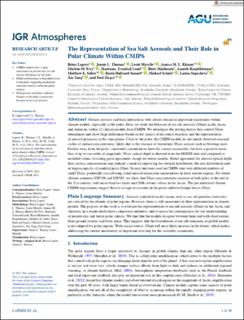| dc.contributor.author | Lapere, Rémy | |
| dc.contributor.author | Thomas, Jennie L. | |
| dc.contributor.author | Marelle, Louis | |
| dc.contributor.author | Ekman, Annica M. L. | |
| dc.contributor.author | Frey, Markus M. | |
| dc.contributor.author | Lund, Marianne Tronstad | |
| dc.contributor.author | Makkonen, Risto | |
| dc.contributor.author | Ranjithkumar, Ananth | |
| dc.contributor.author | Salter, Matthew E. | |
| dc.contributor.author | Samset, Bjørn Hallvard | |
| dc.contributor.author | Schulz, Michael | |
| dc.contributor.author | Sogacheva, Larisa | |
| dc.contributor.author | Yang, Xin | |
| dc.contributor.author | Zieger, Paul | |
| dc.date.accessioned | 2024-02-22T10:56:16Z | |
| dc.date.available | 2024-02-22T10:56:16Z | |
| dc.date.created | 2023-05-04T10:34:44Z | |
| dc.date.issued | 2023 | |
| dc.identifier.citation | Journal of Geophysical Research (JGR): Atmospheres. 2023, 128 (6), . | en_US |
| dc.identifier.issn | 2169-897X | |
| dc.identifier.uri | https://hdl.handle.net/11250/3119291 | |
| dc.description.abstract | Natural aerosols and their interactions with clouds remain an important uncertainty within climate models, especially at the poles. Here, we study the behavior of sea salt aerosols (SSaer) in the Arctic and Antarctic within 12 climate models from CMIP6. We investigate the driving factors that control SSaer abundances and show large differences based on the choice of the source function, and the representation of aerosol processes in the atmosphere. Close to the poles, the CMIP6 models do not match observed seasonal cycles of surface concentrations, likely due to the absence of wintertime SSaer sources such as blowing snow. Further away from the poles, simulated concentrations have the correct seasonality, but have a positive mean bias of up to one order of magnitude. SSaer optical depth is derived from the MODIS data and compared to modeled values, revealing good agreement, except for winter months. Better agreement for aerosol optical depth than surface concentration may indicate a need for improving the vertical distribution, the size distribution and/or hygroscopicity of modeled polar SSaer. Source functions used in CMIP6 emit very different numbers of small SSaer, potentially exacerbating cloud-aerosol interaction uncertainties in these remote regions. For future climate scenarios SSP126 and SSP585, we show that SSaer concentrations increase at both poles at the end of the 21st century, with more than two times mid-20th century values in the Arctic. The pre-industrial climate CMIP6 experiments suggest there is a large uncertainty in the polar radiative budget due to SSaer | en_US |
| dc.language.iso | eng | en_US |
| dc.publisher | AGU | en_US |
| dc.rights | Navngivelse 4.0 Internasjonal | * |
| dc.rights.uri | http://creativecommons.org/licenses/by/4.0/deed.no | * |
| dc.title | The Representation of Sea Salt Aerosols and Their Role in Polar Climate Within CMIP6 | en_US |
| dc.title.alternative | The Representation of Sea Salt Aerosols and Their Role in Polar Climate Within CMIP6 | en_US |
| dc.type | Peer reviewed | en_US |
| dc.type | Journal article | en_US |
| dc.description.version | publishedVersion | en_US |
| dc.source.pagenumber | 0 | en_US |
| dc.source.volume | 128 | en_US |
| dc.source.journal | Journal of Geophysical Research (JGR): Atmospheres | en_US |
| dc.source.issue | 6 | en_US |
| dc.identifier.doi | 10.1029/2022JD038235 | |
| dc.identifier.cristin | 2145364 | |
| dc.relation.project | EC/H2020/821205 | en_US |
| dc.relation.project | Norges forskningsråd: 295046 | en_US |
| dc.relation.project | Sigma2: NS9252K | en_US |
| cristin.ispublished | true | |
| cristin.fulltext | original | |
| cristin.qualitycode | 2 | |

